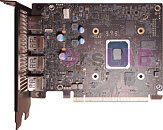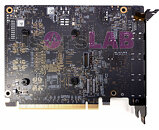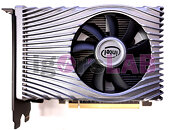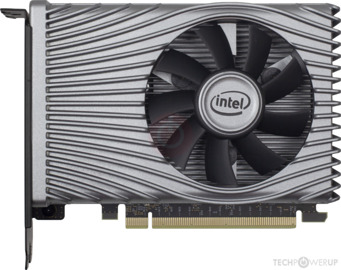- Joined
- Oct 9, 2007
- Messages
- 47,878 (7.38/day)
- Location
- Dublin, Ireland
| System Name | RBMK-1000 |
|---|---|
| Processor | AMD Ryzen 7 5700G |
| Motherboard | Gigabyte B550 AORUS Elite V2 |
| Cooling | DeepCool Gammax L240 V2 |
| Memory | 2x 16GB DDR4-3200 |
| Video Card(s) | Galax RTX 4070 Ti EX |
| Storage | Samsung 990 1TB |
| Display(s) | BenQ 1440p 60 Hz 27-inch |
| Case | Corsair Carbide 100R |
| Audio Device(s) | ASUS SupremeFX S1220A |
| Power Supply | Cooler Master MWE Gold 650W |
| Mouse | ASUS ROG Strix Impact |
| Keyboard | Gamdias Hermes E2 |
| Software | Windows 11 Pro |
Here are some of the first pictures of the Intel Xe DG1 SDV, taken apart to reveal its rather desolate PCB. The Xe DG1 SDV isn't commercially available, but rather distributed by Intel to ISVs, so they can begin optimizing or developing for the Gen12 Xe graphics architecture. The board features a GPU ASIC that's nearly identical to the Iris Xe MAX mobile discrete GPUs, and four LPDDR4 memory chips making up 8 GB of video memory.
The Xe DG1 GPU is based on the Xe LP graphics architecture, and the silicon is built on the 10 nm SuperFin silicon fabrication node. The chip features 96 execution units (768 unified shaders); and apparently makes do with the 75 W power supplied by the PCI-Express slot. A frugal 2-phase VRM powers the GPU. The GPU uses conventional 4-pin PWM to control the fan, which ventilates a simple aluminium mono-block heatsink. Three DisplayPorts and one HDMI 2.1 make up the output configuration. While you won't be able to buy a Xe DG1 SDV in the market (unless an ISV decides to break their NDA and put one up on eBay), Intel has allowed a small number of board partners to develop custom-design cards. ASUS is ready with one. Igor's Lab has more pictures, a list of benchmark fails, and other interesting commentary in the source link below.




View at TechPowerUp Main Site
The Xe DG1 GPU is based on the Xe LP graphics architecture, and the silicon is built on the 10 nm SuperFin silicon fabrication node. The chip features 96 execution units (768 unified shaders); and apparently makes do with the 75 W power supplied by the PCI-Express slot. A frugal 2-phase VRM powers the GPU. The GPU uses conventional 4-pin PWM to control the fan, which ventilates a simple aluminium mono-block heatsink. Three DisplayPorts and one HDMI 2.1 make up the output configuration. While you won't be able to buy a Xe DG1 SDV in the market (unless an ISV decides to break their NDA and put one up on eBay), Intel has allowed a small number of board partners to develop custom-design cards. ASUS is ready with one. Igor's Lab has more pictures, a list of benchmark fails, and other interesting commentary in the source link below.




View at TechPowerUp Main Site









